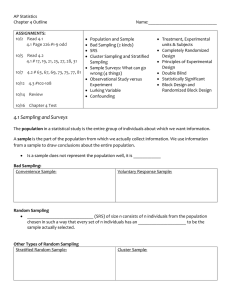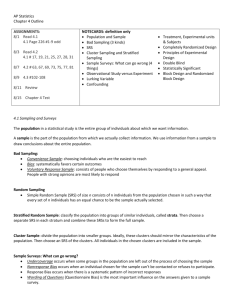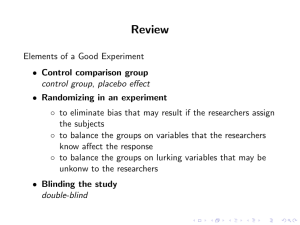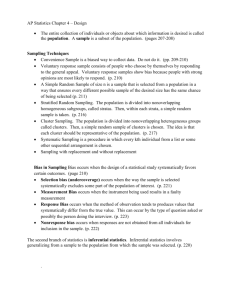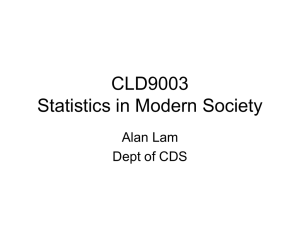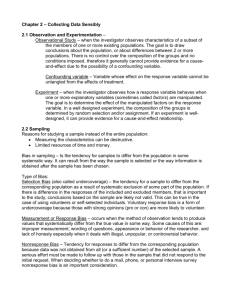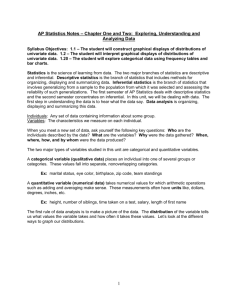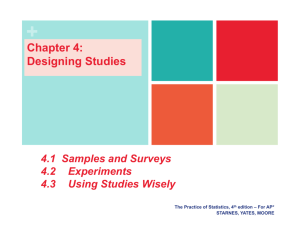Chapter 3: Experimental and Sampling Design, Ethics Section 2.6
advertisement
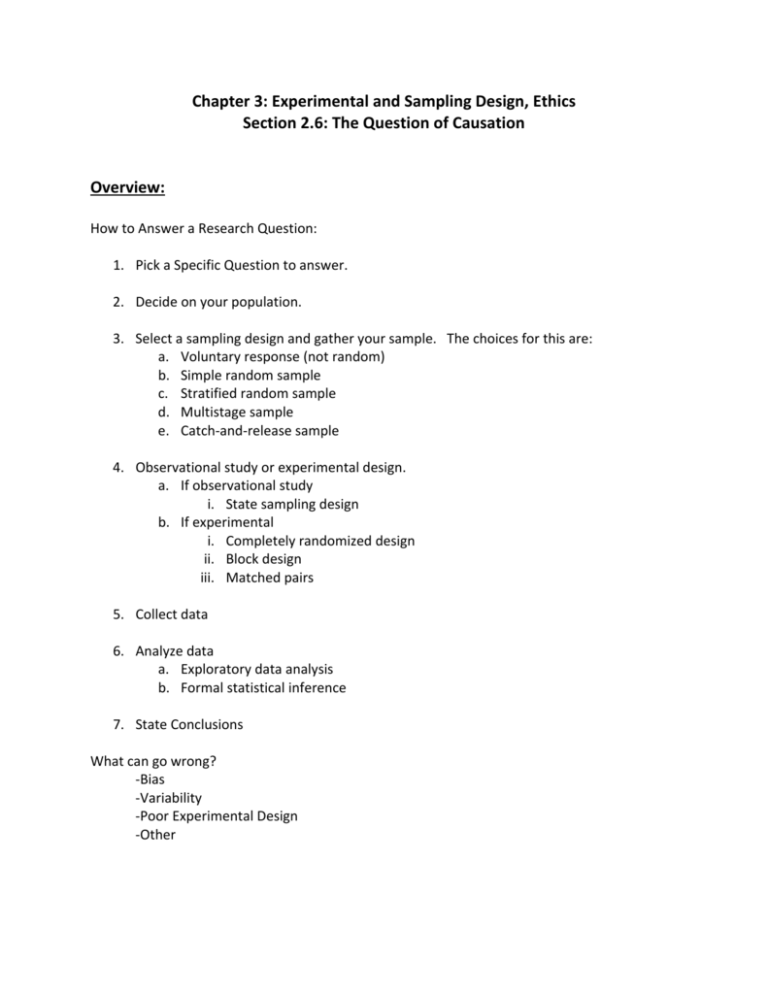
Chapter 3: Experimental and Sampling Design, Ethics Section 2.6: The Question of Causation Overview: How to Answer a Research Question: 1. Pick a Specific Question to answer. 2. Decide on your population. 3. Select a sampling design and gather your sample. The choices for this are: a. Voluntary response (not random) b. Simple random sample c. Stratified random sample d. Multistage sample e. Catch‐and‐release sample 4. Observational study or experimental design. a. If observational study i. State sampling design b. If experimental i. Completely randomized design ii. Block design iii. Matched pairs 5. Collect data 6. Analyze data a. Exploratory data analysis b. Formal statistical inference 7. State Conclusions What can go wrong? ‐Bias ‐Variability ‐Poor Experimental Design ‐Other Think About This: Why are your variables related? Causation is not the same thing as association. ‐Causation ‐Confounding ‐Common Response Principles of Ethical Experiments: ‐Planned studies should be reviewed by a board to protect subjects from harm. ‐All subjects must give their informed consent before data are collected. ‐All individual data must be kept confidential. Only summaries can be made public. (Anonymity is not the same thing as confidentiality) Vocab: Population: The entire group of units or individual about which we want info. Sample: The part of the population selected to be measured or observed in order to gather data for analysis. Census: An attempt to contact every individual in the entire population Response Variable: Variable we are interested in studying Unit: An individual person, animal, or object upon which the response variable is measured. People = individuals Example. A forester is interested in determining the total number of tress that are planted on tree farms in Montana. The forester believes the number of trees varies with the size of the tree farm. He divides all such farms into four classes depending on their size. From each class, he selects a sample of 15 farms. He counts and records the total number of trees for each of the selected tree farms. Unit: Sample: Population: Response Variable: Sampling Design. Anecdotal Evidence: Information gathered haphazardly selected individual cases which often come to our attention because they are striking in some way. Voluntary Response Sample: A sample which consists of people who choose themselves by responding to a general appeal. “Convenience Sampling” Random Sampling: A sample that is selected in such a way that each unity in the population has a non‐zero chance of being chosen. 1.) Simple Random Sample (SRS) of size n: A sample that is selected from the population in such a way that every set of n units has an equal chance of being the selected sample. 2.) Stratified Random Sample: The population is first divided into groups of similar units. A SRS is then selected from each of the groups. 3.) Multi‐stage Sample: A sample in which successively smaller groups within the population are selected in stages. (Used when the population is so large that it is difficult or impossible to get a list of all of the units.) 4.) Capture‐Recapture Sample: Repeated SRS sampling that biologists use to estimate the size of animal populations. Also used by the government when estimating the number of households in an area. How to Take a Random Sample: SPSS or Random Number Table (Table B in the back of the Book) Example: A _________ club needs to take a random sample of 4 member to be representatives at the Worldwide _________________ Convention. Each member should have an equal chance of being selected. The 12 club members are listed as follows: 01 02 03 04 05 06 07 08 09 10 11 12 a.) Use the random number table starting at line 161 (chosen arbitrarily) to take a SRS of 4 members. 161 162 163 164 43400 25831 06283 22138 16043 15706 73345 26238 97341 43251 88153 62336 21112 35574 99271 45297 64578 67197 28310 90341 37531 63890 52630 76315 11022 79124 49525 63078 17229 32165 01343 21394 b.) Use SPSS to take a SRS of 4 members. (You will learn this in Friday’s lab…use the area below to note how it’s done!) Bias in Sampling: Sampling Bias occurs when the sample systematically favors certain parts of the population over others. Types of Sampling Bias: 1.) Undercoverage: occurs when some groups of the population are excluded in the process of choosing the sample. Example‐ Using the phonebook to take a sample of the people in Lafayette. Why is this a problem? 2.) Nonresponse: occurs when a selected unit either cannot be contacted or refuses to cooperate. Example‐ Hanging up on a telemarketer. 3.) Response: when the behavior of the respondent or the interviewer changes the sample result such that the results do not agree with the true population value. (Lying, poor interviewing techniques, race or sex of interviewer influence respondent) Example where respondents might lie: Example where the wording of the question might be a problem: Example where race/sex of interviewer might result in biased answers: Example where the interviewer might influence the respondent: Experiment vs. Observational Study Observational Study: observes individuals and measures variables of interest but does not attempt to influence the responses. Experiment: deliberately imposes a treatment on the units in order to observe their responses Advantages of Experiments: ‐ In principle, experiments can give good evidence for causation. Observational studies are not as good at this. ‐ Experiments allow us to study the specific factors we are interested in, while controlling the effects of lurking variables. ‐ Experiments allow us to study the interaction between factors. Disadvantage of Experiments: ‐ Experiments often lack reality Vocab: Experimental Unit: Individual or units on which the experiment is done. Subjects: Human experimental units Treatment: A specific experimental condition applied to the units. Factors: The explanatory variables being studied. Factor level: A specific level (option for the factor). Example. A sports engineer wants to determine the effects of speed and air pressure on throwing distance for his mechanical trainer football throwing machine. Two speeds (40 mph, 55mph) and three air pressures (175 psi, 200 psi, 230 psi) were chosen for the study. Treatments were randomly assigned to thirty footballs. Experimental Unit: Factors: Treatments: Factor Levels: Response Variable: Problems with a Single Variable Experiment: ‐You may miss lurking variables. ‐You may miss confounding with the placebo effect: a patient responds favorably to being treated not to the treatment itself. ‐Bias: the study itself systematically favors certain outcomes (if you have no control group, your study will be biased towards finding the new medicine effective). ‐Lack of realism: if the subjects know they’re in an experiment, they might not behave naturally during the treatment. The 3 Principles of Experimental Design: 1.) Control the effects of irrelevant (lurking) variables on the response. Doing a comparative experiment with a control group is the simplest form of control. Double‐Blind experiments are even better as neither the subjects nor the personnel who worked with them know which treatment any subject has received. This method avoids any unconscious bias. 2.) Randomization, the use of impersonal chance to select subjects and assign them to treatments. Randomization makes sure that characteristics of the units and/or the judgment of the experimenter do not influence the selection or the treatment assignment. 3.) Replication of the experiment on many subjects reduces chance variation in the results. ***Note: Types of Experimental Design. Completely Randomized Design: Each unit is randomly assigned to a treatment group. Randomized Block Design: A blocking variable distinguishes between different groups going into the experiment. The random assignment of units to treatments is carried out separately within each block. Matched Pairs Design: A design that compares just two treatments. This can occur in one of two ways: ‐Choose pairs of closely matched subjects. Within each pair, randomly assign one individual to each treatment. ‐All subjects receive both treatments. The order of the treatments may be randomly assigned. Statistical Inference. Use a fact about a sample to estimate the truth about the whole population. Parameter ‐> Population ‐A parameter is a number that describes the population. ‐A fixed number that in practice we do not know it’s value Statistic ‐> Sample ‐ A statistic is a number that describes a sample. ‐ We know this value after taking the sample, but it can change from sample to sample (Sampling Variability) ‐ Often used to estimate an unknown parameter Section 2.6 The Question of Causation We are often interested in showing that changes in the explanatory variable cause changes in the response variable. Causation. ‐x and y are associated ‐x causes y to change Note: Remember the 3 principles of experimental design! Also Note: Establishing Causation in Observational Studies ‐The association is strong ‐The association is consistent over many studies. ‐ The alleged cause precedes the effect in time. ‐ The alleged cause is plausible. *Caution: Watch out for Lurking Variables! Lurking variables are neither a response variable nor an explanatory variable in the study but may influence the interpretation of the relationships among those variables. Common Response. ‐x and y are associated ‐z is really what causes changes in both x and y Confounding. ‐x and z are related to each other and both have effects on y ‐it is impossible to separate which effects are from x alone or z alone ‐the confounded variables may be explanatory or lurking variables. Examples. Identify the lurking variable in these relationships. Does the example show common response or confounding? Draw the diagram! a.) The more firefighters who are sent to a fire, the greater the dollars in damage that are reported. b.) A news report said more money per person was spent on alcohol in 2003 than the previous year. It was also reported that teachers’ salaries had been raised. Can we conclude that teachers were spending their extra money on alcohol? c.) Grades tend to be higher in smaller classes. Do smaller class sizes cause grades to be higher? d.) In a 2004 article in the Journal of American Medical Association, researchers found that women who took the most antibiotics (for at least 501 days of their adult lives) have double the risk of developing breast cancer compared to women who didn’t use the drugs. Does this mean that antibiotic use causes breast cancer? Caution: Even well‐established causal relations may not generalize to other settings. Data Ethics

